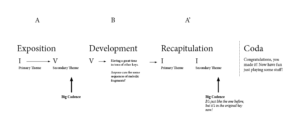What is a Sonata, Anyway?
 The word Sonata is certainly one that most people have encountered at some point in their lives. But, what does it really mean? Is it just a song that lasts longer than normal? Does it have to have a piano? These questions are important for listeners, because they introduce a whole new way of hearing music for someone! For performers, understanding the form is essential to an effective interpretation.
The word Sonata is certainly one that most people have encountered at some point in their lives. But, what does it really mean? Is it just a song that lasts longer than normal? Does it have to have a piano? These questions are important for listeners, because they introduce a whole new way of hearing music for someone! For performers, understanding the form is essential to an effective interpretation.
In today’s usage, a Sonata is understood to be a piece that follows a set form. When it’s written for one instrument alone, or with piano, it’s usually called a Violin/Cello/Piano/etc Sonata. However, the same structure is also used as the building block for String Quartets, Trios, Sextets, and so on. If you write a piece for an entire orchestra that uses this structure, we use another fancy word: a Symphony. Although the entire work could be referred to as a Sonata, the first movement (and many times the fourth movement as well) normally follows a form historically referred to as Sonata-Allegro form. Here’s a brief overview of what that looks like!
Overview
The way a Sonata works is with melodies that move through different keys. More specifically, there is melodic motion from a first, tonic key to the second dominant key (otherwise known as V or five). Assuming that there is no introduction section, the action starts with the aptly named exposition section. A primary theme is presented which establishes the first key (for example, C major). It then uses a transition to modulate to the dominant key for the secondary theme. ( For example, in the key of C Major, the dominant key is G Major) From there, the music moves into the development section where the material is twisted around until it finds its way back to a repeat of the first section in the original key. This is called the recapitulation. The primary theme is heard again exactly as it was heard before. The music will then make a subtle change to the transition it used before to change keys, but it will reorient itself so that it does not modulate. It’s at this point that the most important moment happens: The secondary theme is played in the original key instead of the dominant key. It’s the dramatic climax of the work, and in the best sonatas, everything leading up to it is oriented toward achieving it.
To more easily describe this, here’s a description of the three distinct sections that make up a sonata: Exposition, Development, and Recapitulation (Recap). There is also an optional fourth section, the Coda, which composers can use to extend the end of the piece for a little bit of a fun, or even to add entirely new interpretive ideas:
Exposition
The exposition is where the premise of the story is presented. The original key, which is established with the first theme, goes a long way to establishing the mood of the whole piece. As already mentioned, the sonata then transitions to a second theme in the dominant key. This move to the dominant is important; it marks a journey that the music must take. The satisfaction that the sonata offers is granted by the feeling of moving away from home (the tonic key) and then returning at the end. The way the exposition sets this up determines the effectiveness of everything that follows.
Development
The development is where the composer is allowed to really stretch their skills and show off. The order in which you hear different melodies usually loosely follows the order in which they appeared in the exposition, but they may or may not be recognizable when they are played here. The themes are stretched, pulled, fragmented, and jumbled all together as the composer sees fit.
Where the exposition was about moving from the tonic key to the dominant key, the development is under no such rule. It can travel to any key the composer feels like, and it can arrive there however the composer thinks will be dramatically satisfying. This sometimes means that fragments of the melody cycle through the circle of fifths every measure, or maybe that it moves quickly into a strange, far-away key and stays there for the duration of the section. When composers want to really go crazy, they may even make up a brand new theme that hasn’t been heard before in the piece!
What does all of this mean for interpreting some kind of meaning from the work? The best way to explain it is probably to equate it to the middle story in a trilogy, where your characters are at their darkest points, and the stakes become clear as you prepare for the final ramp up to the climax in the third part. (E.g. The Empire Strikes Back: Han Solo is frozen and given to Jabba the Hut while Luke Skywalker loses his hand and finds out that Darth Vader is his father.)
Recapitulation
Eventually, the development will have to settle down a bit and come back to the primary theme, just like it was heard in the beginning. At this point, you’ve found yourself in the recapitulation, or recap as we might say in modern American English. The recapitulation is very much like a repeat of the exposition, but there is one crucial difference: The secondary theme must cadence in the tonic key, not the dominant. This is how we measure the success or failure of the journey. By achieving a perfect authentic cadence (the strongest kind of harmonic cadence) in the tonic key, the second theme has undergone a transformation. It’s been brought into line with the overall goal of the sonata. It’s almost like coming home from college after graduation; sure, you’re the same person, but you’ve undergone a big process of change that turns you into the mature adult you were always meant to be.
If the cadence is successful, the only thing that’s left to do is continue to play out the remaining music from the exposition, still in the tonic key. You make it to the final bar and feel rightly proud of yourself!
On the other hand: perhaps you weren’t successful. Perhaps the second theme never quite made it to the right key and it just gets left behind as a failure. There’s a lot of interpretive power there that can range from lost hopes and dreams to being forever alone without love. This gives the Sonata a bittersweet or tragic quality, regardless of it being in a major or minor key (here’s looking at you, Brahms).
Coda
This is something that becomes more important as you move later on in music history, but the presence of a big coda can also tell you a lot about what the composer is trying to express. Traditionally, the only thing the coda is supposed to do is have a bunch of fun, with redundant cadences to celebrate the success of the journey. It gives a big dramatic finish and reinforces the eighteenth-century Enlightenment ideals that gave birth to this whole form in the first place.
However, as composers write more and more sonatas, they start to get a little experimental with things. We can give Beethoven the credit for starting this rule-breaking trend with the final movement of his third symphony. The coda he writes ends up going on for 15 minutes! It’s the equivalent of getting to the end of a superhero movie, watching the main character beat the bad guy, have a celebration, and then find out—PLOT TWIST—the bad guy is still alive and needs to be defeated again! It was an effective tool for making his material take on a larger than life quality. What he’s implicitly saying here is that his music cannot be constrained by convention. In order to truly find a solution to the puzzles he’s presented, he has to go beyond the known forms and into uncharted territory.
Sonata-Allegro form has been a cornerstone of music for 250 years, and all of the famous composers would have written very different music if this form hadn’t been in place. Understanding this form goes a long way to understanding the Western classical music tradition as a whole. This was just a very brief overview of what makes up a Sonata, and there are countless more aspects to the form and tradition that an interested learner could seek out.
As a way to apply your new knowledge of Sonata-Allegro from, check out this annotated video of the first movement of Mozart’s Dissonance Quartet played by our very own string teachers! Each section’s name will appear on the screen as it happens.



